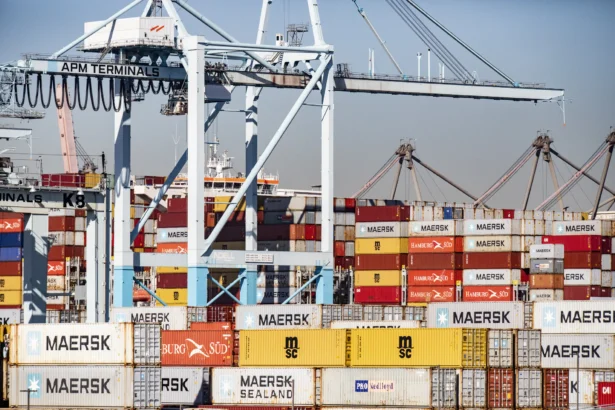Steve Madden, a $3 billion shoe company, plans to reduce imports from China by as much as 45 percent over the next year ahead of President-elect Donald Trump’s pledge to impose sweeping tariffs.
CEO Edward Rosenfeld confirmed to shareholders and analysts during a Nov. 7 earnings call that the shoe brand is “planning for a potential scenario” in which it “would have to move goods out of China more quickly.”
“As of yesterday morning, we are putting that plan into motion,” Rosenfeld said. “And you should expect to see the percentage of goods that we sourced from China to begin to come down more rapidly going forward.”
According to Rosenfeld, imports into the United States represent approximately two-thirds of the company’s business, with China accounting for 70 percent of those products.
Over the next year, the company aims to reduce the percentage of goods that it sources from China by about 40–45 percent. If the business accomplishes this goal, it “would be looking at just over a quarter of [the] business that would be subject to potential tariffs on Chinese goods.”
“If we are contemplating a new policy where there are significant tariffs on China, that’s going to have all sorts of wide-ranging implications not only in the supply chain, but the overall economy,” Rosenfeld said.
Other American and foreign companies have discussed the coming era of global tariffs in their earnings calls.
Ralph Lauren Chief Financial Officer Justin Picicci expressed little concern that the fashion brand will endure turbulence navigating tariffs because it has diversified its supply chain and sourcing.
“Our global sourcing and supply chain is agile and well-positioned,” Picicci said in an earnings call on Nov. 7. “So we’ll wait and see what, if any, future policy ultimately gets passed. But we’ve navigated tariffs successfully before, including not so long ago.”
U.S. manufacturer Yeti says there are still plenty of uncertainties surrounding the tariff policy. At the same time, says Yeti Chief Financial Officer Mike McMullen, the company would assess prices “as an option to offset any potential tariff risk.”
“So, basically, we’re focused on the things that we can control,” McMullen said during a recent earnings call.
Tapestry, the parent company of the Coach and Kate Spade brands, estimates that fewer than 10 percent of overall sourcing originates from China. While the company monitors the tariff policy, the apparel maker has adapted to various “disruptions and challenges,” says the company’s chief financial officer, Scott Roe.
“My goodness, we’ve had so many disruptions and challenges that have forced us to make adaptions based on port strikes and freight lanes, whatever it might be, tariff regimes changing over time,” Roe said. “So, we’re pretty well versed in managing through this.”
BMW CEO Oliver Zipse downplayed fears about potential tariffs from the incoming administration.
“We shouldn’t be too nervous about what might happen,” Zipse said in a recent earnings call.
Foreign markets “tend to be highly sensitive to trade restrictions,” Goldman Sachs Research economists said in a note emailed to The Epoch Times.
“The prospect for trade tariffs is one of the main policy implications that investors are focused on following the election of Donald Trump as U.S. president,” they said.

“Our economists have also downgraded their forecasts for European GDP growth, reflecting the increase in trade uncertainty and the prospect for increased tariffs. By contrast, U.S. stocks are typically less volatile relative to the broader stock market to changes in world trade.”
Eric Clark, portfolio manager of the Rational Dynamic Brands Fund, says companies have already adapted to current U.S. trade policy, though the effects of new levies on brands—and consumers—might vary.
“Any new tariffs might force every company to raise prices,” Clark said in a note emailed to The Epoch Times. “Some brands have the ability to raise prices, and some brands don’t. If consumers get more price hikes, that will force them even more to tighten their belt and make different decisions.”
Back-of-the-Envelope Tariff Calculations
During the 2024 election campaign, Trump had pledged to institute sweeping tariffs. He has proposed a blanket universal 10–20 percent tariff on all imported goods into the United States. In addition, he has suggested levies between 60 and 100 percent for products from China.
The president-elect has suggested that his tariff agenda would accomplish two goals: generate new sources of revenue for the federal government and protect American jobs.
“To me, the most beautiful word in the dictionary is tariff. It’s my favorite word. It needs a public relations firm,” Trump said at the Economic Club of Chicago in October.
Revenue estimates vary.
The nonpartisan Tax Foundation, for example, forecasts that a universal 10 percent tariff would raise $2 trillion for the U.S. government between 2025 and 2034. Likewise, a 20 percent tariff would inject $3.3 trillion into government coffers.
The Tax Policy Center projects a 10 percent across-the-board import tax, and a 60 percent Chinese tariff would garner about $2.8 trillion in net new federal revenues over the next decade.
In his first term, Trump imposed tariffs on a wide range of goods from China, Europe, Canada, and Mexico. Despite President Joe Biden’s criticisms throughout the 2020 election, the current administration has kept many of the Trump-era trade levies in place and, in some cases, doubled down on them.
The United States imports between $3 trillion and $4 trillion of goods annually, according to data from the U.S. Census Bureau.
Tariffs are taxes on imports paid by U.S. companies purchasing goods from foreign markets such as China or Europe.
From The Epoch Times
